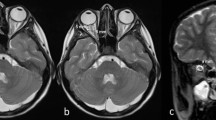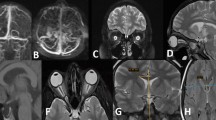Abstract
The aim of this study was to evaluate the accuracy of previously reported neuroimaging signs in establishing or excluding the diagnosis of idiopathic intracranial hypertension (IIH). In a retrospective study, 30 patients with confirmed IIH and 56 controls were evaluated with brain magnetic resonance imaging. All examinations were evaluated in a blinded fashion by three neuroradiologists for the presence or absence of the ‘traditional’ signs of IIH: empty sella turcica, deformation of the pituitary, slit-like ventricles, ‘tight’ subarachnoid spaces, flattening of the posterior globe, protrusion of the optic nerve, enhancement of the optic nerve head, distension of the optic nerve sheath and vertical tortuosity of the optic nerve. Optic nerve protrusion and enhancement, slit-like ventricles and tight cerebrospinal fluid spaces were not significantly associated with IIH (P>0.05). Posterior globe flattening, optic nerve sheath distension, optic nerve tortuosity, pituitary deformity and empty sella turcica were significantly associated with IIH (P<0.05). However, most of these are not helpful in a clinical setting, with the exception of posterior globe flattening. This is the only sign that, if present, strongly suggests the diagnosis of IIH (specificity 100%, 95% CI 93.6% to 100%; sensitivity 43.5%, 95% CI 27.3% to 60.8%; positive likelihood ratio 49.7). The majority of the reported signs for IIH on cross-sectional imaging are not helpful in establishing or excluding the diagnosis of IIH, and are of no value in the clinical setting. Flattening of the posterior aspect of the globe is the only sign that, if present, is suggestive of the diagnosis of IIH.






Similar content being viewed by others
References
Friedman DI, Jacobson DM (2002) Diagnostic criteria for idiopathic intracranial hypertension. Neurology 59:1492–1495
Farb RI, Vanek I, Scott J, Mikulis DJ, Willinsky RA, Tomlinson G, terBrugge KG (2003) Idiopathic intracranial hypertension: the prevalence and morphology of sinovenous stenosis. Neurology 60:1418–1424
Weisberg LA (1985) Computed tomography in benign intracranial hypertension. Neurology 35:1075–1078
Gibby WA, Cohen MS, Goldberg HI, Sergott RC (1993) Pseudotumor cerebri: CT findings and correlation with vision loss. AJR Am J Roentgenol 160:143–146
Yuh WT, Zhu M, Taoka T, Quets JP, Maley JE, Muhonen MG, Schuster ME, Kardon RH (2000) MR imaging of pituitary morphology in idiopathic intracranial hypertension. J Magn Reson Imaging 12:808–813
Gass A, Barker GJ, Riordan-Eva P, MacManus D, Sanders M, Tofts PS, McDonald WI, Moseley IF, Miller DH (1996) MRI of the optic nerve in benign intracranial hypertension. Neuroradiology 38:769–773
Kesler A, Yaffe D, Shapira M, Kott E (1996) Optic nerve sheath enlargement and reversal of optic nerve head in pseudotumor cerebri (in Hebrew). Harefuah 130:457–459, 503
Brodsky MC, Vaphiades M (1998) Magnetic resonance imaging in pseudotumor cerebri. Ophthalmology 105:1686–1693
Zagardo MT, Cail WS, Kelman SE, Rothman MI (1996) Reversible empty sella in idiopathic intracranial hypertension: an indicator of successful therapy? AJNR Am J Neuroradiol 17:1953–1956
Jaeschke R, Guyatt GH, Sackett DL (1994) Users’ guides to the medical literature. III. How to use an article about a diagnostic test. B. What are the results and will they help me in caring for my patients? The Evidence-Based Medicine Working Group. JAMA 271(9):703–707
Fleiss JL (1981) Statistical methods for rates and proportions. Wiley, New York
Manfre L, Lagalla R, Mangiameli A, Lupo F, Giuffre G, Ponte F, Cardinale AE (1995) Idiopathic intracranial hypertension: orbital MRI. Neuroradiology 37(6):459–461
Yuh WT, Simonson TM, Wang AM, Koci TM, Tali ET, Fisher DJ, Simon JH, Jinkins JR, Tsai F (1994) Venous sinus occlusive disease: MR findings. AJNR Am J Neuroradiol 15:309–316
Huckman MS, Fox JS, Ramsey RG, Penn RD (1976) Computed tomography in the diagnosis of pseudotumor cerebri. Radiology 119:593–597
Silbergleit R, Junck L, Gebarski SS, Hatfield MK (1989) Idiopathic intracranial hypertension (pseudotumor cerebri): MR imaging. Radiology 170:207–209
Jacobson DM, Karanjia PN, Olson KA, Warner JJ (1990) Computed tomography ventricular size has no predictive value in diagnosing pseudotumor cerebri. Neurology 40:1454–1455
Gideon P, Sorensen PS, Thomsen C, Stahlberg F, Gjerris F, Henriksen O (1995) Increased brain water self-diffusion in patients with idiopathic intracranial hypertension. AJNR Am J Neuroradiol 16:381–387
Karahalios DG, Rekate HL, Khayata MH, Apostolides PJ (1996) Elevated intracranial venous pressure as a universal mechanism in pseudotumor cerebri of varying etiologies. Neurology 46:198–202
Johnston I, Kollar C, Dunkley S, Assaad N, Parker G (2002) Cranial venous outflow obstruction in the pseudotumour syndrome: incidence, nature and relevance. J Clin Neurosci 9:273–278
Lee AG, Brazis PW (2000) Magnetic resonance venography in idiopathic pseudotumor cerebri. J Neuroophthalmol 20:12–13
Conflict of interest statement
We declare that we have no conflict of interest.
Author information
Authors and Affiliations
Corresponding author
Rights and permissions
About this article
Cite this article
Agid, R., Farb, R.I., Willinsky, R.A. et al. Idiopathic intracranial hypertension: the validity of cross-sectional neuroimaging signs. Neuroradiology 48, 521–527 (2006). https://doi.org/10.1007/s00234-006-0095-y
Received:
Accepted:
Published:
Issue Date:
DOI: https://doi.org/10.1007/s00234-006-0095-y




